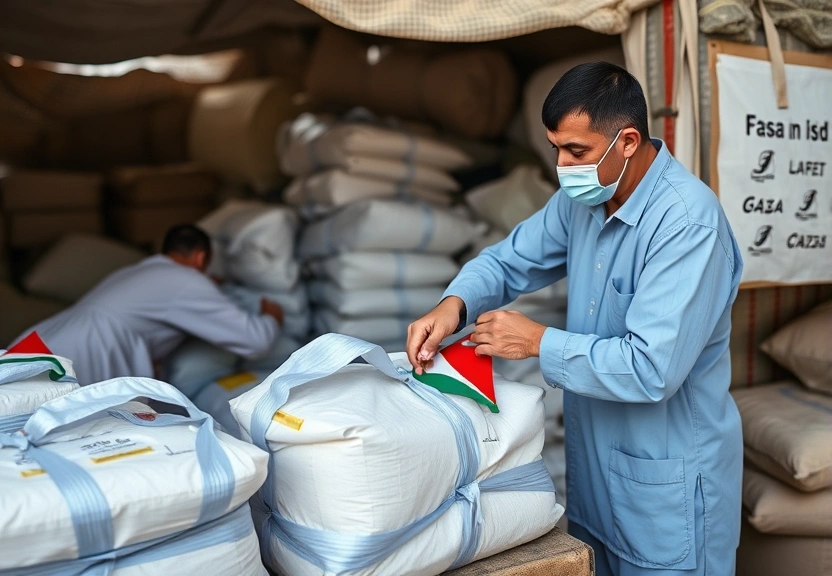Controversial Gaza Aid Operation Pauses for 24 Hours After Days of Deadly Shootings
The humanitarian crisis in Gaza has reached alarming levels, prompting urgent calls for aid from various international organizations. Recently, a new aid operation backed by the United States and Israel has been initiated to address the overwhelming needs of the Palestinian population. However, the operation has encountered significant challenges, including violent incidents that have left several Palestinians dead. On Wednesday, the distribution of aid was paused for 24 hours after a series of shootings targeted individuals en route to aid distribution sites, raising concerns about the safety and effectiveness of the operation.

This article delves into the ongoing humanitarian crisis in Gaza, the controversial nature of the US-Israel-backed aid operation, the implications of recent shootings, and the broader impact on the Palestinian population. As the situation develops, it is crucial to understand the complexities and challenges associated with delivering aid in a conflict zone.
The Humanitarian Crisis in Gaza
Gaza, a densely populated area, has been under blockade for over a decade, leading to severe shortages of essential resources. The ongoing conflict between Hamas and Israel has exacerbated the humanitarian situation, with civilians often caught in the crossfire. According to reports from various humanitarian organizations, a significant portion of the population is dependent on aid for survival.
Humanitarian Needs Assessment
As of late 2023, the needs assessment conducted by the United Nations indicates that over 2 million people in Gaza require immediate assistance. This includes access to food, clean water, medical care, and shelter. The deteriorating conditions have resulted in increased malnutrition rates, particularly among children, and a spike in preventable diseases.
Challenges in Delivering Aid
The delivery of humanitarian aid in Gaza is fraught with challenges. Restrictions on movement, ongoing violence, and bureaucratic hurdles complicate the distribution process. Additionally, the recent rise in shootings has raised questions about the safety of aid workers and beneficiaries alike, making it increasingly difficult to provide necessary support.
The US-Israel-Backed Aid Operation
The recent aid operation, spearheaded by a controversial organization supported by the United States and Israel, aims to address the pressing needs of the Palestinian population. This initiative has been met with skepticism from various quarters, as many view it as a politically motivated effort rather than a genuine humanitarian response.
Objectives of the Aid Operation
The primary objectives of this aid operation include:
- Distributing food and medical supplies to vulnerable communities.
- Providing temporary shelters for displaced families.
- Offering psychological support to those affected by the ongoing conflict.
Criticism and Concerns
Despite its stated goals, the operation has faced criticism for several reasons:
- Political Bias: Critics argue that the aid is being used as a tool to legitimize Israeli policies in the region.
- Lack of Local Input: Many local organizations have expressed concern that they were not consulted in the planning process.
- Safety Risks: The recent shootings have highlighted the dangers that aid workers face in the field.
The Impact of Shootings on Aid Distribution
The recent wave of shootings directed at Palestinians trying to access aid distribution sites has raised grave concerns. For three consecutive days, individuals en route to receive essential supplies were met with violence, resulting in fatalities and injuries. This alarming trend has prompted a temporary halt to aid operations, raising questions about the feasibility of continuing such initiatives under dangerous conditions.
Consequences of Violence
The consequences of the shootings extend beyond immediate physical harm. Many Palestinians are now hesitant to participate in aid distribution efforts, fearing for their safety. This reluctance can lead to increased desperation and isolation among those in need, undermining the objectives of the aid operation.
Reactions from the International Community
The international community has reacted with concern over the shootings. Calls for an independent investigation into the incidents have intensified, with various human rights organizations urging accountability for the violence. Furthermore, there are demands for a reassessment of the aid operation to ensure that it prioritizes the safety and well-being of the affected population.
The future of aid distribution in Gaza remains uncertain. While the need for humanitarian assistance is undeniable, the operational environment continues to be fraught with risks. As the situation evolves, several factors will influence the prospects for effective aid delivery.
Potential Solutions
To navigate the complexities of aid distribution in Gaza, several strategies could be considered:
- Enhanced Security Measures: Implementing robust security protocols to protect aid workers and beneficiaries may mitigate risks.
- Collaboration with Local Organizations: Engaging local groups in the planning and execution of aid distribution can increase effectiveness and community trust.
- International Oversight: Establishing independent oversight mechanisms may help ensure transparency and accountability in aid operations.
Community Engagement
Engaging with local communities to understand their needs and priorities is crucial for the success of any aid operation. By incorporating their perspectives, humanitarian organizations can tailor their responses to better meet the specific challenges faced by Gazans.
FAQs about Gaza Aid and the Recent Operations
1. Why was the Gaza aid operation paused?
The Gaza aid operation was paused for 24 hours due to a series of shootings that targeted Palestinians on their way to distribution sites, resulting in fatalities and raising safety concerns.
2. Who is behind the US-Israel-backed aid operation?
The aid operation is being spearheaded by a new organization that receives backing from the United States and Israel, aiming to address the humanitarian crisis in Gaza.
3. What are the main challenges in delivering aid to Gaza?
Challenges include ongoing violence, restrictions on movement, bureaucratic hurdles, and safety risks for aid workers and recipients.
4. How has the international community responded to the recent violence?
The international community has expressed concern over the shootings, calling for an independent investigation and reassessment of the aid operation’s safety protocols.
5. What steps can be taken to improve aid distribution in Gaza?
Potential steps include enhanced security measures, collaboration with local organizations, and increased community engagement to tailor aid responses to specific needs.
Conclusion
The recent pause in the Gaza aid operation underscores the complexities and dangers inherent in delivering humanitarian assistance in conflict zones. While the need for aid is critical, ensuring the safety of those involved in distribution efforts is equally important. As the humanitarian crisis in Gaza continues to unfold, it is imperative for the international community to address both the immediate needs of the population and the broader challenges that hinder effective aid delivery. Through collaboration, transparency, and a commitment to prioritizing the well-being of affected communities, a more sustainable and impactful approach to humanitarian aid in Gaza can be achieved.
📰 Original Source
Este artigo foi baseado em informações de: https://www.cnn.com/2025/06/04/middleeast/gaza-aid-operation-24-hour-pause-intl


